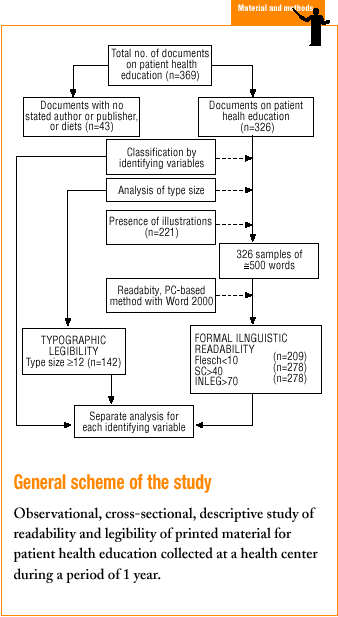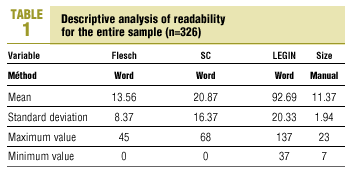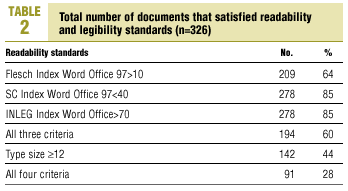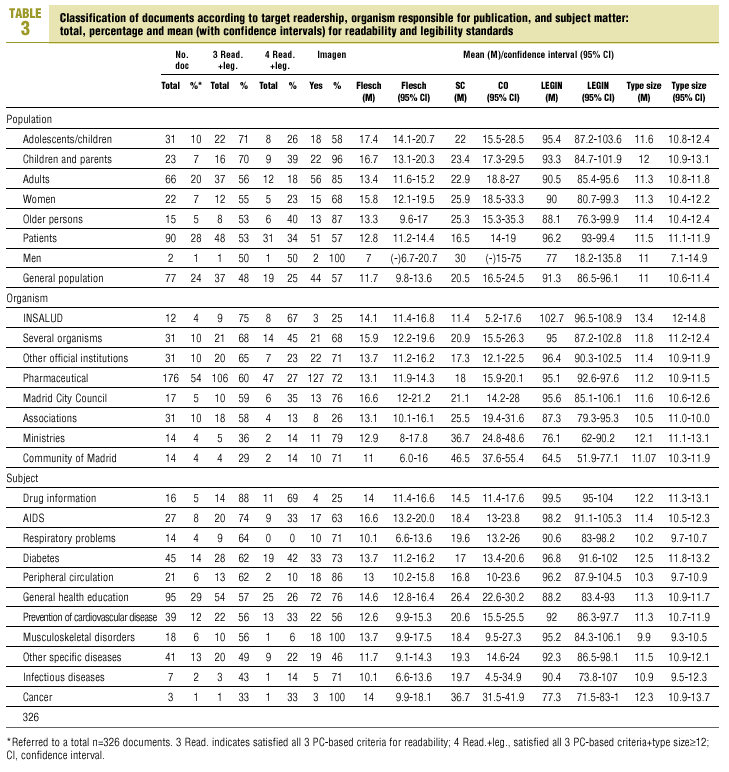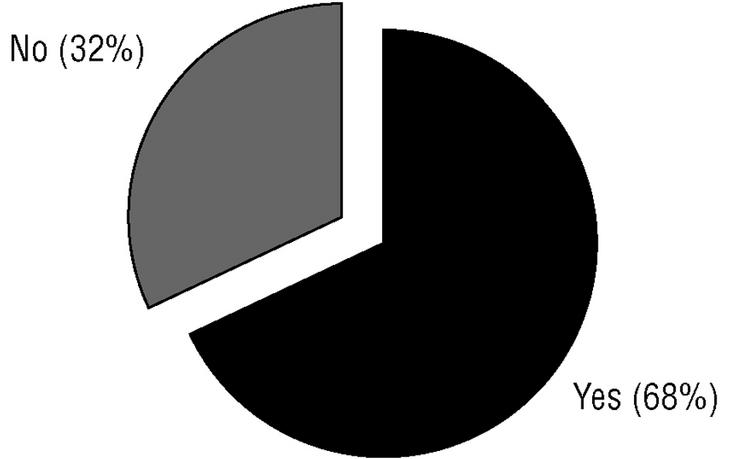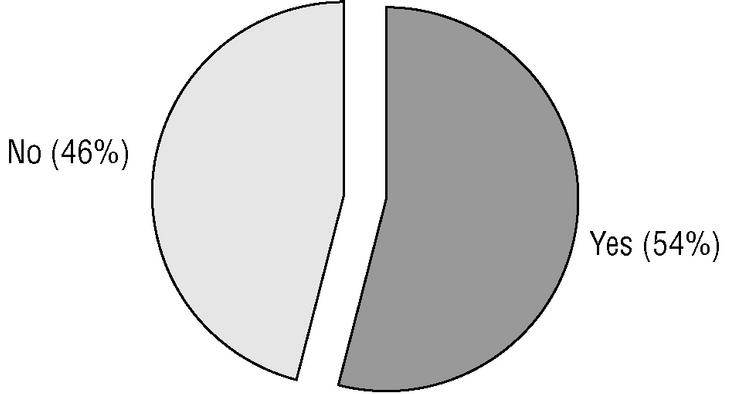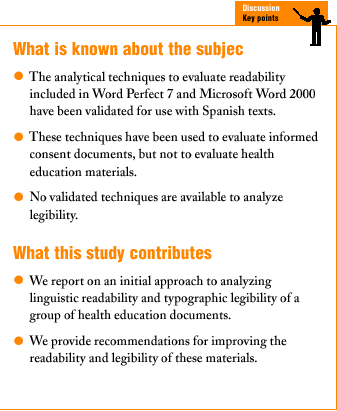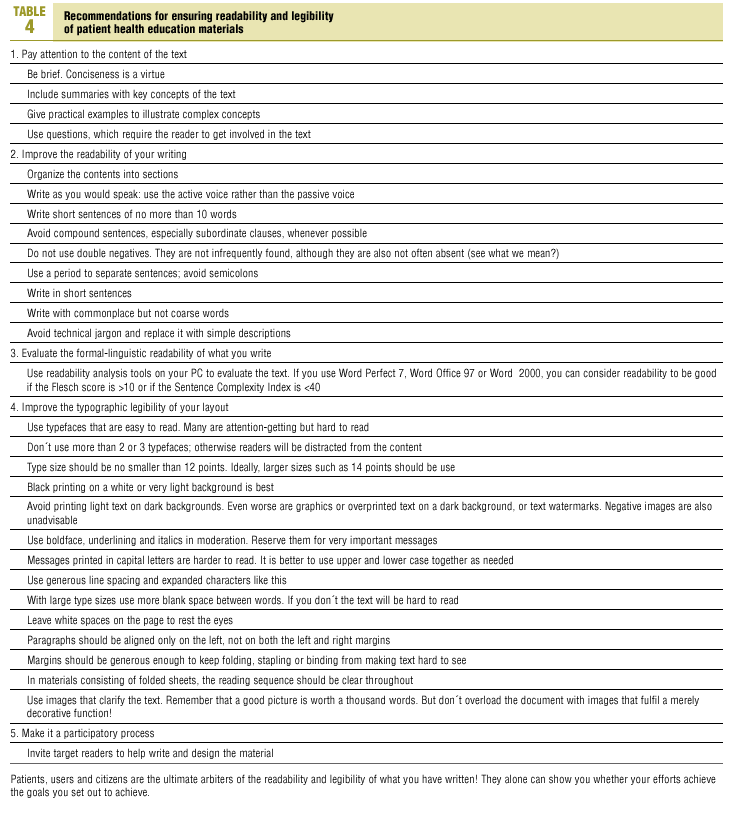Introduction
During their lifetime patients receive an enormous amount of printed information, which they often seem to have problems understanding.1 Comprehension of a given text may depend on factors related to the patient as the receptor. But more often, the problem lies in the sender, i.e., the practitioner, who provides the information in unreadable language that is hard to follow. This undermines the purpose of information, which is to communicate truthfully so that the patient may play an active part in decision-making based on the best available evidence.2
According to Aliende, readability «is the set of characteristics of texts which favor or hinder effective communication between texts and readers, in accordance with a reader´s competence and the conditions under which reading takes place.»3 Each of these characteristics can be identified with a certain type of readability. Two of the most widely studied types are typographical legibility and linguistic readability. The former analyzes the text per se to evaluate the printing, color and size of the paper and print, the presence of illustrations and their function, the distribution of white space, and other features. The latter analyzes text as a linguistic message, and the techniques used for such evaluations have been based mainly on how the text is constructed (word length, sentence length, grammatical structures, etc.), in what is called formal-linguistic readability. These techniques have been widely developed for the English language, and have been applied to analyze patient education materials.4-13 In Spain the Flesch technique included with Word Perfect 7 and Microsoft Word 2000 for personal computers had been validated.14 However, no validated tests are available for typographical legibility. Patient health education is an activity inherent in primary care, and is an interactive process in which all forms of language play a part.15 However, printed materials undoubtedly occupy an important position, and should thus be readable and understandable by patients.
The aim of this study was to analyze readability and some features of legibility in printed documents for patient health education used by practitioners especially nurses at a health care center in Madrid.
Material and methods
This was an observational, descriptive study.
Setting
The Avenida de Daroca Health Center, serving IMSALUD (Madrid Health Service) Primary Health Care Area 4 in Madrid, Spain. This urban health care center employs more than 50 professionals and provides primary care to approximately 40 000 persons.
Material
Between 1 June 2000 and 1 June 2001 we systematically collected copies of all printed materials for patient health education aimed at health center users and made available to patients anywhere in the health center. We also collected copies of materials provided by pharmaceutical sales representatives for professionals. The materials analyzed consisted of pamphlets, leaflets, loose sheets, «mini-guides», books, and material in any other printed format. We excluded diet sheets for various total daily kilocalorie intakes, and materials in which no author or publisher could be reliably identified.
Analytical tools and variables analyzed
To evaluate formal-linguistic readability we used the tool that accompanies Microsoft Word 2000,16 which estimates the Flesch readability score on a scale between 0 (very difficult) and 100 (very easy). This score correlates well with the original manual system of Flesch, validated by Simón and Carro in 1993.17 The program also calculates Sentence Complexity Index (SC), on a scale between 0 (very easy) and 100 (very complicated). As a complement to the Flesch Index and SC we also calculated the Integrated Legibility Index (INLEG) of Simón, Barrio and Concheiro (1996),18 which provides a mathematical relationship between the two indices described above on a scale from 0 (very difficult) to 200 (very easy). According to these authors, readability is considered appropriate at a Flesch score of 10 or higher, an SC score lower than 40, and an INLEG score higher than 70. Readability is considered optimum when all three criteria are met.
To evaluate typographical legibility we first recorded whether the type size used for the body text (not for titles and headings) was 12 points or larger. This is a common recommendation for this type of printed material,19 and is therefore considered a standard measure of legibility. We then noted whether the text was accompanied by one or more illustrations that complemented the text rather than serving a simply decorative purpose. Because no objective criteria are available for this, we decided not to consider the role of illustrations as a standard evaluation criterion, but only as a complementary factor.
Variables that identified the documents were recorded as the organism responsible for publishing the material, the target readership, and the subject matter. Year of publication, when stated, was also noted.
Data processing and statistical analysis
The documents were classified according to the variables used to identify source, readership and subject. Type size was noted, and illustrations were recorded. The first 500 words of text from each document were sampled for readability, on the assumption that the beginning of the text played a key role in attracting the reader´s attention. The document was scanned and prepared according to previous recommendations20 for analysis with Microsoft Word 2000, and the results were transferred to an Excel table21 for processing. Data for qualitative variables were expressed as absolute numbers, and those for quantitative variables were expressed as absolute numbers for readability of the text sample from each document, and as the mean and standard deviation, maximum and minimum values and 95% confidence interval for pooled results.
Results
A total of 369 documents were collected, of which only 326 fulfilled the inclusion criteria and were subsequently analyzed. Table 1 shows the results of our analysis of formal-linguistic readability in the 326 documents, and of type size. Table 2 shows the number of documents that fulfilled each readability and legibility standard. Figure 1 illustrates the percentages of documents that contained illustrations, and figure 2 shows the percentages that stated the year of publication. Readability and legibility were also analyzed according to target readership, organism responsible for publication, and topic (Table 3).
Figure 1. Percentage of pamphlets with illustrations.
Figure 2. Date of publication.
Discussion
A surprising result was the large number of patient health education materials collected during the 1-year study period. This indicates that considerable resources are devoted to the production of such materials; this in turn makes it necessary to ensure their efficacy and quality. As shown in Table 1, formal-linguistic readability appeared to be acceptable. However, the findings for typographic legibility were worse. The detailed breakdown in Table 2 shows that 4 of every 10 pamphlets failed to comply with at least one criterion for formal-linguistic readability, particularly the Flesch score excessively long sentences and words), and that 6 of every 10 were printed in typeface that was too small to be comfortably legible. Writers and graphic designers seem to be aware of the need for simple language, but appear to be less aware of the need for a visible type size. Nonetheless they appear to be sensitive to the inclusion of explanatory illustrations, in view of the results shown in Figure 1. Documents aimed at children and adolescents (Table 3) were the most legible. In contrast, the low scores for materials aimed at older persons, particularly with regard to type size, were surprising. Legibility was worse in materials aimed at the general public. There appeared to be no large differences in legibility between materials that dealt with different subjects.
Surprisingly, readability was best for medications, which tend to be associated with complex information. Drugs for musculoskeletal disorders are interesting because the readability of information on this group of drugs was low and legibility was poor (small type size); although these problems were offset by the large number of illustrations. With regard to publishing entities, the most important finding was the overwhelming superiority of the pharmaceutical industry. However, their printed materials did not appear to be the most readable, and were much less so than materials provided by the (now dismantled) national health service (INSALUD). We noted that materials published by the Community of Madrid or by any of the government ministries contained high-quality illustrations but scored poorly for readability. No date of publication was given in almost half of the pamphlets, which made it impossible to judge how current they were a problem that limits their credibility and effectiveness.
We found only one article in Spanish similar to the present study: a report on the readability of educational materials about breastfeeding.22 This study used the SMOG and FOG formulas but did not validate the method, hence its results are difficult to evaluate. The SMOG formula and Bernier´s BIDS scale were proposed by the Grupo de Educación Sanitaria del PAPPS to evaluate patient health education materials, although these methods were not validated.23 However, the present study also has important limitations, e.g., the nonrandom text sampling used for each document, and difficulties in generalizing our findings to all printed documents for patient health education in Spain or in our community. Further studies are needed to obtain additional evidence, and to develop new, validated techniques to analyze readability and particularly typographical legibility.
In conclusion, Table 4 lists some empirical recommendations for improving the readability of patient health education materials. Of these recommendations, derived from the lessons of the present study, the most important, we feel, is the last one in the table.24,25
Correspondence: Inés M. Barrio Cantalejo. C/ Casuarina, 7. 28044 Madrid. España. E-mail: ibarrio@eresmas.net
This research forms part of a larger project titled «Can Patients Read What We Want Them to Read?», which was commended the XXIst Certamen de Enfermería San Juan de Dios.
Manuscript received 27 May 2002.
Manuscript accepted for publication 11 November 2002.





